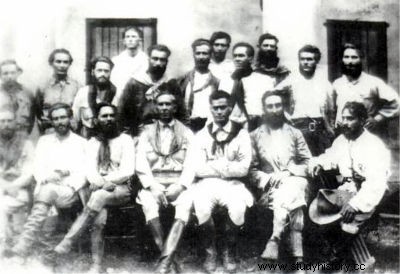
By Me. Cláudio Fernandes
The so-called Column Prestes took place between 1925 and 1927 and became known by that name because its main leader was the gaucho military man Luís Carlos Preste s. This movement was formed from two revolutionary fronts of soldiers linked to Tenentismo . Such fronts operated in the states of São Paulo and Rio Grande do Sul, respectively, and their main objective was to overthrow the oligarchic representatives of the Republic Old, embodied in the figures of the presidents Arthur Bernardes (who ruled until 1926) and Washington Louis , which was deposed by the Revolution of 1930 .
The São Paulo matrix of what became Coluna Prestes had its origins in the flight of lieutenants who participated in the Revolution of 1924 , in Sao Paulo city. Unable to resist the federal government's offensive, the rebels fled towards Rio Grande do Sul, where the revolutionary focus had also been highlighted, especially due to the actions of Captain Luís Carlos Prestes. Prestes and the other rebels from Rio Grande do Sul marched towards Paraná, where they met with the Paulistas in April 1925.
From this meeting was born the Miguel Costa column - Luís Carlos Prestes , which bears the names of the representative from São Paulo and the representative from Rio Grande do Sul, respectively. In the words of historian Boris Fausto:
“[…] The column carried out an incredible march through the interior of the country, covering about 24 thousand kilometers until February/March 1927, when its remnants ended the movement and were interned in Bolivia and Paraguay. Its components never exceeded 1,500 people, fluctuating a lot with the entry and exit of transient participants. The Column avoided clashing with considerable military forces, moving quickly from one point to another. The support of the rural population was nothing more than an illusion, and the chances of military success were practically nil. However, it had a symbolic effect among sections of the urban population dissatisfied with the ruling elite. For these sectors, there were hopes of changing the destiny of the Republic, as shown by those heroes who ran all the risks to save a nation .” [1]
Throughout the 24,000 kilometers that the Coluna Prestes lieutenants traveled, they intended to spread an insurrectionary perspective in Brazil. This perspective was heir to “salvationism ” from the beginning of the Republic, an ideology disseminated by former President Marshal Hermes da Fonseca, which imbued the army with the “mission” of radically transforming the country.
At the end of the day, the members of the Column dispersed along the borders of Brazil with Bolivia and Paraguay, exiling themselves in these two countries.
NOTES
[1] FAUSTO, Boris. History of Brazil . São Paulo:EDUSP, 2013. pp. 266-267.
